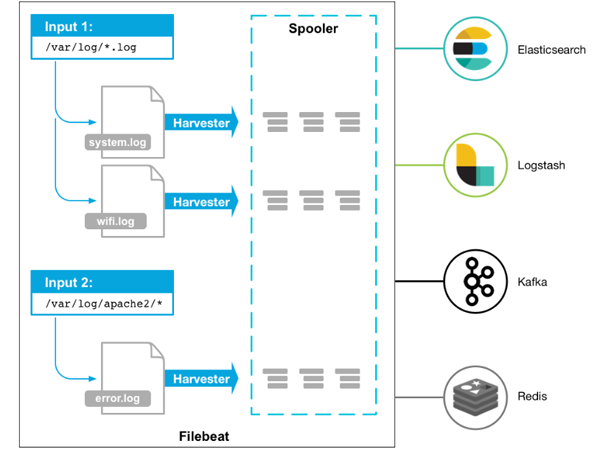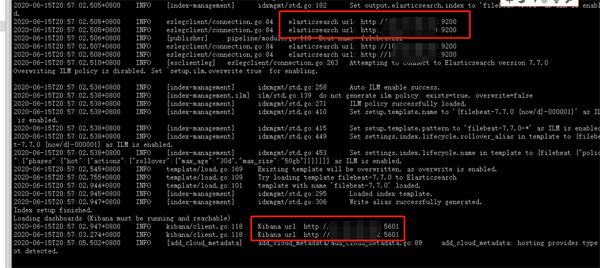您好,登錄后才能下訂單哦!
您好,登錄后才能下訂單哦!
本篇內容介紹了“日志采集利器Filebeat的用法”的有關知識,在實際案例的操作過程中,不少人都會遇到這樣的困境,接下來就讓小編帶領大家學習一下如何處理這些情況吧!希望大家仔細閱讀,能夠學有所成!
本文使用的Filebeat是7.7.0的版本,文章將從如下幾個方面說明:
Filebeat是什么,可以用來干嘛
Filebeat的原理是怎樣的,怎么構成的
Filebeat應該怎么玩
Filebeat是什么

Filebeat和Beats的關系
首先Filebeat是Beats中的一員。
Beats在是一個輕量級日志采集器,其實Beats家族有6個成員,早期的ELK架構中使用Logstash收集、解析日志,但是Logstash對內存、CPU、io等資源消耗比較高。相比Logstash,Beats所占系統的CPU和內存幾乎可以忽略不計。
目前Beats包含六種工具:
Packetbeat:網絡數據(收集網絡流量數據)
Metricbeat:指標(收集系統、進程和文件系統級別的CPU和內存使用情況等數據)
Filebeat:日志文件(收集文件數據)
Winlogbeat:Windows事件日志(收集Windows事件日志數據)
Auditbeat:審計數據(收集審計日志)
Heartbeat:運行時間監控(收集系統運行時的數據)
Filebeat是什么
Filebeat是用于轉發和集中日志數據的輕量級傳送工具。Filebeat監視您指定的日志文件或位置,收集日志事件,并將它們轉發到Elasticsearch或 Logstash進行索引。
Filebeat的工作方式如下:啟動Filebeat時,它將啟動一個或多個輸入,這些輸入將在為日志數據指定的位置中查找。對于Filebeat所找到的每個日志,Filebeat都會啟動收集器。每個收集器都讀取單個日志以獲取新內容,并將新日志數據發送到libbeat,libbeat將聚集事件,并將聚集的數據發送到為Filebeat配置的輸出。
工作的流程圖如下:

Filebeat和Logstash的關系
因為Logstash是JVM跑的,資源消耗比較大,所以后來作者又用Golang寫了一個功能較少但是資源消耗也小的輕量級的logstash-forwarder。不過作者只是一個人,加入http://elastic.co公司以后,因為ES公司本身還收購了另一個開源項目Packetbeat,而這個項目專門就是用Golang的,有整個團隊,所以ES公司干脆把logstash-forwarder的開發工作也合并到同一個Golang團隊來搞,于是新的項目就叫Filebeat了。
Filebeat原理是什么
Filebeat的構成
Filebeat結構:由兩個組件構成,分別是inputs(輸入)和harvesters(收集器),這些組件一起工作來跟蹤文件并將事件數據發送到您指定的輸出,harvester負責讀取單個文件的內容。harvester逐行讀取每個文件,并將內容發送到輸出。為每個文件啟動一個harvester。harvester負責打開和關閉文件,這意味著文件描述符在harvester運行時保持打開狀態。如果在收集文件時刪除或重命名文件,Filebeat將繼續讀取該文件。這樣做的副作用是,磁盤上的空間一直保留到harvester關閉。默認情況下,Filebeat保持文件打開,直到達到close_inactive。
關閉harvester可以會產生的結果:
文件處理程序關閉,如果harvester仍在讀取文件時被刪除,則釋放底層資源。
只有在scan_frequency結束之后,才會再次啟動文件的收集。
如果該文件在harvester關閉時被移動或刪除,該文件的收集將不會繼續。
一個input負責管理harvesters和尋找所有來源讀取。如果input類型是log,則input將查找驅動器上與定義的路徑匹配的所有文件,并為每個文件啟動一個harvester。每個input在它自己的Go進程中運行,Filebeat當前支持多種輸入類型。每個輸入類型可以定義多次。日志輸入檢查每個文件,以查看是否需要啟動harvester、是否已經在運行harvester或是否可以忽略該文件。
Filebeat如何保存文件的狀態
Filebeat保留每個文件的狀態,并經常將狀態刷新到磁盤中的注冊表文件中。該狀態用于記住harvester讀取的最后一個偏移量,并確保發送所有日志行。如果無法訪問輸出(如Elasticsearch或Logstash),Filebeat將跟蹤最后發送的行,并在輸出再次可用時繼續讀取文件。當Filebeat運行時,每個輸入的狀態信息也保存在內存中。當Filebeat重新啟動時,來自注冊表文件的數據用于重建狀態,Filebeat在最后一個已知位置繼續每個harvester。對于每個輸入,Filebeat都會保留它找到的每個文件的狀態。由于文件可以重命名或移動,文件名和路徑不足以標識文件。對于每個文件,Filebeat存儲唯一的標識符,以檢測文件是否以前被捕獲。
Filebeat何如保證至少一次數據消費
Filebeat保證事件將至少傳遞到配置的輸出一次,并且不會丟失數據。是因為它將每個事件的傳遞狀態存儲在注冊表文件中。在已定義的輸出被阻止且未確認所有事件的情況下,Filebeat將繼續嘗試發送事件,直到輸出確認已接收到事件為止。如果Filebeat在發送事件的過程中關閉,它不會等待輸出確認所有事件后再關閉。當Filebeat重新啟動時,將再次將Filebeat關閉前未確認的所有事件發送到輸出。這樣可以確保每個事件至少發送一次,但最終可能會有重復的事件發送到輸出。通過設置shutdown_timeout選項,可以將Filebeat配置為在關機前等待特定時間。
Filebeat怎么玩
壓縮包方式安裝
本文采用壓縮包的方式安裝,Linux版本,filebeat-7.7.0-linux-x86_64.tar.gz。
curl-L-Ohttps://artifacts.elastic.co/downloads/beats/filebeat/filebeat-7.7.0-linux-x86_64.tar.gz tar -xzvf filebeat-7.7.0-linux-x86_64.tar.gz
配置示例文件:filebeat.reference.yml(包含所有未過時的配置項)
配置文件:filebeat.yml
基本命令
詳情見官網:https://www.elastic.co/guide/en/beats/filebeat/current/command-line-options.html
export #導出 run #執行(默認執行) test #測試配置 keystore #秘鑰存儲 modules #模塊配置管理 setup #設置初始環境
例如:./filebeat test config #用來測試配置文件是否正確
輸入輸出
支持的輸入組件:
Multilinemessages,Azureeventhub,CloudFoundry,Container,Docker,GooglePub/Sub,HTTPJSON,Kafka,Log,MQTT,NetFlow,Office 365 Management Activity API,Redis,s3,Stdin,Syslog,TCP,UDP(最常用的就是Log)
支持的輸出組件:
Elasticsearch,Logstash,Kafka,Redis,File,Console,ElasticCloud,Changetheoutputcodec(最常用的就是Elasticsearch,Logstash)
keystore的使用
keystore主要是防止敏感信息被泄露,比如密碼等,像ES的密碼,這里可以生成一個key為ES_PWD,值為ES的password的一個對應關系,在使用ES的密碼的時候就可以使用${ES_PWD}使用。
創建一個存儲密碼的keystore:filebeat keystore create
然后往其中添加鍵值對,例如:filebeatk eystore add ES_PWD
使用覆蓋原來鍵的值:filebeat key store add ES_PWD–force
刪除鍵值對:filebeat key store remove ES_PWD
查看已有的鍵值對:filebeat key store list
例如:后期就可以通過${ES_PWD}使用其值,例如:
output.elasticsearch.password:"${ES_PWD}"filebeat.yml配置(Log輸入類型為例)
詳情見官網:https://www.elastic.co/guide/en/beats/filebeat/current/filebeat-input-log.html
type: log #input類型為log enable: true #表示是該log類型配置生效 paths: #指定要監控的日志,目前按照Go語言的glob函數處理。沒有對配置目錄做遞歸處理,比如配置的如果是: - /var/log/* /*.log #則只會去/var/log目錄的所有子目錄中尋找以".log"結尾的文件,而不會尋找/var/log目錄下以".log"結尾的文件。 recursive_glob.enabled: #啟用全局遞歸模式,例如/foo/**包括/foo, /foo/*, /foo/*/* encoding:#指定被監控的文件的編碼類型,使用plain和utf-8都是可以處理中文日志的 exclude_lines: ['^DBG'] #不包含匹配正則的行 include_lines: ['^ERR', '^WARN'] #包含匹配正則的行 harvester_buffer_size: 16384 #每個harvester在獲取文件時使用的緩沖區的字節大小 max_bytes: 10485760 #單個日志消息可以擁有的最大字節數。max_bytes之后的所有字節都被丟棄而不發送。默認值為10MB (10485760) exclude_files: ['\.gz$'] #用于匹配希望Filebeat忽略的文件的正則表達式列表 ingore_older: 0 #默認為0,表示禁用,可以配置2h,2m等,注意ignore_older必須大于close_inactive的值.表示忽略超過設置值未更新的 文件或者文件從來沒有被harvester收集 close_* #close_ *配置選項用于在特定標準或時間之后關閉harvester。 關閉harvester意味著關閉文件處理程序。 如果在harvester關閉 后文件被更新,則在scan_frequency過后,文件將被重新拾取。 但是,如果在harvester關閉時移動或刪除文件,Filebeat將無法再次接收文件 ,并且harvester未讀取的任何數據都將丟失。 close_inactive #啟動選項時,如果在制定時間沒有被讀取,將關閉文件句柄 讀取的最后一條日志定義為下一次讀取的起始點,而不是基于文件的修改時間 如果關閉的文件發生變化,一個新的harverster將在scan_frequency運行后被啟動 建議至少設置一個大于讀取日志頻率的值,配置多個prospector來實現針對不同更新速度的日志文件 使用內部時間戳機制,來反映記錄日志的讀取,每次讀取到最后一行日志時開始倒計時使用2h 5m 來表示 close_rename #當選項啟動,如果文件被重命名和移動,filebeat關閉文件的處理讀取 close_removed #當選項啟動,文件被刪除時,filebeat關閉文件的處理讀取這個選項啟動后,必須啟動clean_removed close_eof #適合只寫一次日志的文件,然后filebeat關閉文件的處理讀取 close_timeout #當選項啟動時,filebeat會給每個harvester設置預定義時間,不管這個文件是否被讀取,達到設定時間后,將被關閉 close_timeout 不能等于ignore_older,會導致文件更新時,不會被讀取如果output一直沒有輸出日志事件,這個timeout是不會被啟動的, 至少要要有一個事件發送,然后haverter將被關閉 設置0 表示不啟動 clean_inactived #從注冊表文件中刪除先前收獲的文件的狀態 設置必須大于ignore_older+scan_frequency,以確保在文件仍在收集時沒有刪除任何狀態 配置選項有助于減小注冊表文件的大小,特別是如果每天都生成大量的新文件 此配置選項也可用于防止在Linux上重用inode的Filebeat問題 clean_removed #啟動選項后,如果文件在磁盤上找不到,將從注冊表中清除filebeat 如果關閉close removed 必須關閉clean removed scan_frequency #prospector檢查指定用于收獲的路徑中的新文件的頻率,默認10s tail_files:#如果設置為true,Filebeat從文件尾開始監控文件新增內容,把新增的每一行文件作為一個事件依次發送, 而不是從文件開始處重新發送所有內容。 symlinks:#符號鏈接選項允許Filebeat除常規文件外,可以收集符號鏈接。收集符號鏈接時,即使報告了符號鏈接的路徑, Filebeat也會打開并讀取原始文件。 backoff: #backoff選項指定Filebeat如何積極地抓取新文件進行更新。默認1s,backoff選項定義Filebeat在達到EOF之后 再次檢查文件之間等待的時間。 max_backoff: #在達到EOF之后再次檢查文件之前Filebeat等待的最長時間 backoff_factor: #指定backoff嘗試等待時間幾次,默認是2 harvester_limit:#harvester_limit選項限制一個prospector并行啟動的harvester數量,直接影響文件打開數 tags #列表中添加標簽,用過過濾,例如:tags: ["json"] fields #可選字段,選擇額外的字段進行輸出可以是標量值,元組,字典等嵌套類型 默認在sub-dictionary位置 filebeat.inputs: fields: app_id: query_engine_12 fields_under_root #如果值為ture,那么fields存儲在輸出文檔的頂級位置 multiline.pattern #必須匹配的regexp模式 multiline.negate #定義上面的模式匹配條件的動作是 否定的,默認是false 假如模式匹配條件'^b',默認是false模式,表示講按照模式匹配進行匹配 將不是以b開頭的日志行進行合并 如果是true,表示將不以b開頭的日志行進行合并 multiline.match # 指定Filebeat如何將匹配行組合成事件,在之前或者之后,取決于上面所指定的negate multiline.max_lines #可以組合成一個事件的最大行數,超過將丟棄,默認500 multiline.timeout #定義超時時間,如果開始一個新的事件在超時時間內沒有發現匹配,也將發送日志,默認是5s max_procs #設置可以同時執行的最大CPU數。默認值為系統中可用的邏輯CPU的數量。 name #為該filebeat指定名字,默認為主機的hostname
實例一:Logstash作為輸出
filebeat.yml配置:
#=========================== Filebeat inputs ============================= filebeat.inputs: # Each - is an input. Most options can be set at the input level, so # you can use different inputs for various configurations. # Below are the input specific configurations. - type: log # Change to true to enable this input configuration. enabled: true # Paths that should be crawled and fetched. Glob based paths. paths: #配置多個日志路徑 -/var/logs/es_aaa_index_search_slowlog.log -/var/logs/es_bbb_index_search_slowlog.log -/var/logs/es_ccc_index_search_slowlog.log -/var/logs/es_ddd_index_search_slowlog.log #- c:\programdata\elasticsearch\logs\* # Exclude lines. A list of regular expressions to match. It drops the lines that are # matching any regular expression from the list. #exclude_lines: ['^DBG'] # Include lines. A list of regular expressions to match. It exports the lines that are # matching any regular expression from the list. #include_lines: ['^ERR', '^WARN'] # Exclude files. A list of regular expressions to match. Filebeat drops the files that # are matching any regular expression from the list. By default, no files are dropped. #exclude_files: ['.gz$'] # Optional additional fields. These fields can be freely picked # to add additional information to the crawled log files for filtering #fields: # level: debug # review: 1 ### Multiline options # Multiline can be used for log messages spanning multiple lines. This is common # for Java Stack Traces or C-Line Continuation # The regexp Pattern that has to be matched. The example pattern matches all lines starting with [ #multiline.pattern: ^\[ # Defines if the pattern set under pattern should be negated or not. Default is false. #multiline.negate: false # Match can be set to "after" or "before". It is used to define if lines should be append to a pattern # that was (not) matched before or after or as long as a pattern is not matched based on negate. # Note: After is the equivalent to previous and before is the equivalent to to next in Logstash #multiline.match: after #================================ Outputs ===================================== #----------------------------- Logstash output -------------------------------- output.logstash: # The Logstash hosts #配多個logstash使用負載均衡機制 hosts: ["192.168.110.130:5044","192.168.110.131:5044","192.168.110.132:5044","192.168.110.133:5044"] loadbalance: true #使用了負載均衡 # Optional SSL. By default is off. # List of root certificates for HTTPS server verifications #ssl.certificate_authorities: ["/etc/pki/root/ca.pem"] # Certificate for SSL client authentication #ssl.certificate: "/etc/pki/client/cert.pem" # Client Certificate Key #ssl.key: "/etc/pki/client/cert.key"
./filebeat -e #啟動filebeat
Logstash的配置:
input { beats { port => 5044 } } output { elasticsearch { hosts => ["http://192.168.110.130:9200"] #這里可以配置多個 index => "query-%{yyyyMMdd}" } }實例二:Elasticsearch作為輸出
filebeat.yml的配置:
###################### Filebeat Configuration Example ######################### # This file is an example configuration file highlighting only the most common # options. The filebeat.reference.yml file from the same directory contains all the # supported options with more comments. You can use it as a reference. # # You can find the full configuration reference here: # https://www.elastic.co/guide/en/beats/filebeat/index.html # For more available modules and options, please see the filebeat.reference.yml sample # configuration file. #=========================== Filebeat inputs ============================= filebeat.inputs: # Each - is an input. Most options can be set at the input level, so # you can use different inputs for various configurations. # Below are the input specific configurations. - type: log # Change to true to enable this input configuration. enabled: true # Paths that should be crawled and fetched. Glob based paths. paths: -/var/logs/es_aaa_index_search_slowlog.log -/var/logs/es_bbb_index_search_slowlog.log -/var/logs/es_ccc_index_search_slowlog.log -/var/logs/es_dddd_index_search_slowlog.log #- c:\programdata\elasticsearch\logs\* # Exclude lines. A list of regular expressions to match. It drops the lines that are # matching any regular expression from the list. #exclude_lines: ['^DBG'] # Include lines. A list of regular expressions to match. It exports the lines that are # matching any regular expression from the list. #include_lines: ['^ERR', '^WARN'] # Exclude files. A list of regular expressions to match. Filebeat drops the files that # are matching any regular expression from the list. By default, no files are dropped. #exclude_files: ['.gz$'] # Optional additional fields. These fields can be freely picked # to add additional information to the crawled log files for filtering #fields: # level: debug # review: 1 ### Multiline options # Multiline can be used for log messages spanning multiple lines. This is common # for Java Stack Traces or C-Line Continuation # The regexp Pattern that has to be matched. The example pattern matches all lines starting with [ #multiline.pattern: ^\[ # Defines if the pattern set under pattern should be negated or not. Default is false. #multiline.negate: false # Match can be set to "after" or "before". It is used to define if lines should be append to a pattern # that was (not) matched before or after or as long as a pattern is not matched based on negate. # Note: After is the equivalent to previous and before is the equivalent to to next in Logstash #multiline.match: after #============================= Filebeat modules =============================== filebeat.config.modules: # Glob pattern for configuration loading path: ${path.config}/modules.d/*.yml # Set to true to enable config reloading reload.enabled: false # Period on which files under path should be checked for changes #reload.period: 10s #==================== Elasticsearch template setting ========================== #================================ General ===================================== # The name of the shipper that publishes the network data. It can be used to group # all the transactions sent by a single shipper in the web interface. name: filebeat222 # The tags of the shipper are included in their own field with each # transaction published. #tags: ["service-X", "web-tier"] # Optional fields that you can specify to add additional information to the # output. #fields: # env: staging #cloud.auth: #================================ Outputs ===================================== #-------------------------- Elasticsearch output ------------------------------ output.elasticsearch: # Array of hosts to connect to. hosts: ["192.168.110.130:9200","92.168.110.131:9200"] # Protocol - either `http` (default) or `https`. #protocol: "https" # Authentication credentials - either API key or username/password. #api_key: "id:api_key" username: "elastic" password: "${ES_PWD}" #通過keystore設置密碼./filebeat -e #啟動Filebeat
查看Elasticsearch集群,有一個默認的索引名字filebeat-%{[beat.version]}-%{+yyyy.MM.dd}

Filebeat模塊
官網:https://www.elastic.co/guide/en/beats/filebeat/current/filebeat-modules.html
這里我使用Elasticsearch模式來解析ES的慢日志查詢,操作步驟如下,其他的模塊操作也一樣:
前提:安裝好Elasticsearch和Kibana兩個軟件,然后使用Filebeat。
具體的操作官網有:https://www.elastic.co/guide/en/beats/filebeat/current/filebeat-modules-quickstart.html
第一步,配置filebeat.yml文件:
#============================== Kibana ===================================== # Starting with Beats version 6.0.0, the dashboards are loaded via the Kibana API. # This requires a Kibana endpoint configuration. setup.kibana: # Kibana Host # Scheme and port can be left out and will be set to the default (http and 5601) # In case you specify and additional path, the scheme is required: http://localhost:5601/path # IPv6 addresses should always be defined as: https://[2001:db8::1]:5601 host: "192.168.110.130:5601" #指定kibana username: "elastic" #用戶 password: "${ES_PWD}" #密碼,這里使用了keystore,防止明文密碼 # Kibana Space ID # ID of the Kibana Space into which the dashboards should be loaded. By default, # the Default Space will be used. #space.id: #================================ Outputs ===================================== # Configure what output to use when sending the data collected by the beat. #-------------------------- Elasticsearch output ------------------------------ output.elasticsearch: # Array of hosts to connect to. hosts: ["192.168.110.130:9200","192.168.110.131:9200"] # Protocol - either `http` (default) or `https`. #protocol: "https" # Authentication credentials - either API key or username/password. #api_key: "id:api_key" username: "elastic" #es的用戶 password: "${ES_PWD}" # es的密碼 #這里不能指定index,因為我沒有配置模板,會自動生成一個名為filebeat-%{[beat.version]}-%{+yyyy.MM.dd}的索引第二步,配置Elasticsearch的慢日志路徑:
cd filebeat-7.7.0-linux-x86_64/modules.d
vim elasticsearch.yml:

第三步,生效ES模塊:
./filebeat modules elasticsearch
查看生效的模塊:
./filebeat modules list

第四步,初始化環境:
./filebeat setup -e

第五步,啟動Filebeat:
./filebeat -e
查看Elasticsearch集群,如下圖所示,把慢日志查詢的日志都自動解析出來了:

到這里,Elasticsearch這個module就實驗成功了。
“日志采集利器Filebeat的用法”的內容就介紹到這里了,感謝大家的閱讀。如果想了解更多行業相關的知識可以關注億速云網站,小編將為大家輸出更多高質量的實用文章!
免責聲明:本站發布的內容(圖片、視頻和文字)以原創、轉載和分享為主,文章觀點不代表本網站立場,如果涉及侵權請聯系站長郵箱:is@yisu.com進行舉報,并提供相關證據,一經查實,將立刻刪除涉嫌侵權內容。